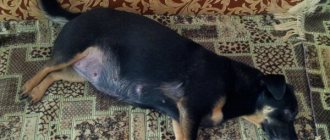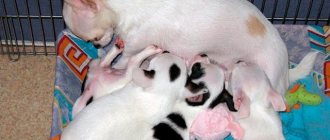If your dog is pregnant and her water breaks, get ready for a life-changing moment: She's about to give birth. During this second stage of labor after contractions, your dog may secrete what looks like water, but is actually amniotic fluid that protects the puppy in the womb.
This signals the imminent arrival of the puppies - so be prepared! Hospitals recommend having a clean, large box, known as a puppy box, in which she can give birth, as well as veterinarian contact information in case problems arise.
How long after mating do dogs give birth and how many puppies can there be in a litter?
A dog bears offspring for an average of 63 days. But everything is individual. The exact date of birth is difficult to determine. It depends on:
- female size - small breeds of dogs give birth earlier, at about 59-60 days (a Yorkshire terrier can give birth 57-58 days after mating);
- breeds Labrador, husky, German shepherd - these animals sometimes have long and difficult labor;
- number of puppies. In multiple pregnancies, labor occurs earlier and the process itself occurs faster;
- dog's age;
- complications that arise during pregnancy;
- number of previous pregnancies. Primiparous females often carry puppies to term.
In the last weeks of pregnancy
Any pregnancy in dogs is multiple. Each litter contains at least 2 puppies, 1 is born extremely rarely. Most often, 4-10 puppies are born. Their number depends on the breed and the number of fertilized eggs. Sometimes a multiple pregnancy, for example, an animal carries not 5 puppies, but 16, which does not correspond to its build, is a pathology. In this case, veterinarian intervention is necessary. He will also tell you how dogs give birth.
Bubble exit
Postpartum discharge
The babies are born, and the dog’s body is being cleansed. The owner notices a discharge that gradually turns from brown and thick to light, and then transparent. This is a natural self-cleaning process.
If you notice that there is bleeding, purulent discharge with an unpleasant odor, or an increased body temperature, you should contact a veterinarian.
If bleeding occurs after childbirth, you need to call a veterinarian.
Features of feeding a dog before giving birth and caring for it
A pregnant bitch should eat balanced food rich in vitamins and nutrients. Approximately 1-2 weeks before giving birth, limit the amount of food containing calcium. The animal is denied:
- milk and cottage cheese;
- eggs;
- yogurt.
Yorkie pregnancy by day: details about childbirth at home
If dog food contains soy, it should not be used either. Instead, the animal is given fresh meat - beef, rabbit, boiled liver and heart. It is useful to feed your pet vegetables. It could be pumpkin, zucchini or carrots.
Important! To compensate for the lack of Omega-3 and Omega-6 fatty acids in the body, fish oil is given.
Shortly before the expected birth, they begin to prepare a place for the dog.
Place for birth
Yorkies in heat, mating and childbirth at home
If the bitch previously had problems with bearing and giving birth to puppies, she could not give birth on her own, or the offspring turned out to be non-viable, then the next birth of the dog is carried out under the supervision of a veterinarian. To do this, she is taken to the clinic. A healthy dog gives birth on its own, without outside help. The main thing is to prepare a place where she could retire during childbirth. This could be a bedding in some corner or a cardboard (wooden) box with high sides.
The bottom of the box is covered with old rags in several layers to make the animal comfortable. You will also need to prepare bedding to replace the one that is dirty (amniotic fluid, afterbirth comes out).
The animal must have its own place
You should not allow your pet to give birth on the sofa or bed. The furniture will be damaged. The animal is shown a box prepared for it in advance. It is advisable to place it where the bitch usually sleeps or eats. If the dog does not react to the box or does not want to get into it, they force it into it for a week, leaving it alone with its favorite toy or treat.
Behavioral and physiological signs of beginning labor
Mating of Spitz: when the heat begins, childbirth at home
Even at the time of mating, you should ask how you can understand that a dog is giving birth and how puppies are born in different breeds.
The puppy is connected by the umbilical cord to its mother
Psychological signs of impending labor appear earlier than physiological ones. The first warning sign is panic. The animal becomes restless:
- stirs up the litter with his paws;
- howls, whines;
- refuses to respond to a nickname;
- breathing heavily;
- cannot find a place for himself, lies down and immediately gets up, can run around the room.
Some dogs react to the approach of labor by refusing food and water. There is no need to touch the animal in an attempt to calm its activity.
About 3-4 days before giving birth, the bitch's belly sags. She seems to have suddenly lost several kilograms of weight. But that's not true. The puppies simply move closer to the birth canal that is ready to open. At the same time, other physiological signs of the imminent appearance of offspring appear:
- Mucus is released from the vagina. This occurs due to relaxation of the ligamentous apparatus of the sacral joint and pelvis. The plug comes out, which prevents the puppies from being born before their due date. Concerned about the presence of mucus, the dog vigorously licks itself. This should not be prevented.
- Colostrum oozes from the nipples. If a dog gives birth for the first time, the nipples often increase only slightly in size. With repeated and subsequent births, milk begins to be released.
- Body temperature decreases. The norm is 39 degrees. Shortly before birth, the temperature drops to 37-37.5.
The described physiological and mental changes allow us to conclude that childbirth is approaching and it is necessary to monitor the dog, providing all possible assistance if necessary.
Box for the expectant mother
How to tell if your dog's water has broken
The main sign of the beginning of the labor process is the breaking of water and the onset of contractions. Shortly before the puppies are born, there may be a slight vaginal discharge. But usually the dog licks off all the released fluids and its owner does not notice anything. There is a lot of amniotic fluid, so it is difficult not to notice that it has receded. And yet, in order not to miss the moment, it is better to lay a light piece of fabric instead of the usual bedding.
The appearance of a large dark spot on a light background will indicate that the waters have broken and labor has begun. The waters do not necessarily break just before the puppies arrive. Sometimes there is an interval of 24-96 hours between the discharge of amniotic fluid and the first attempts.
Important! If no contractions are observed after 4 days after the water breaks, immediately contact a specialist.
How to tell if your dog is having contractions
To understand that the pet has begun prenatal contractions, place your hand on the dog’s stomach. At first the stomach seems very hard, but after a second, on the contrary, soft. The uterus contracts, tensing and relaxing.
Some animals whine and howl when pushing. This is fine. It is difficult to answer the question of how long contractions last in dogs. Their duration depends on the number of puppies, the age of the bitch and the physical characteristics of the body.
Anxiety before childbirth
Pregnancy by days and months
The duration of pregnancy is about two months. During this time, changes occur:
| Day | What's happening |
| 1 | Fertilization as a result of mating. |
| 2 | Repeated mating, the gradual movement of sperm to fully formed eggs. |
| 3 | Sperm in the uterine tubes. |
| 4 | Fertilization. |
| 5-11 | The eggs enter the uterus. |
| 12-14 | Formation of embryos. |
| 15 | The embryos begin to form internal organs. |
| 16 | Embryos reach a length of 1 mm. |
| 17 | The central nervous system, head and torso develop. |
| 18-19 | The length of the fetus is 2 mm, internal organs continue to form. |
| 20-24 | The placenta, heart, liver, organs of hearing, vision, smell, jaws are formed, the embryo reaches 1 cm. |
| 25-29 | Teeth, front and hind limbs are growing. |
| 30-32 | Hair appears on the 2 cm long embryo. |
| 33 | The fruit increases to 2.7 cm. |
| 34-36 | The pregnant bitch becomes calm and her appetite improves. |
| 37-40 | The skeletal system of dachshunds is growing, their length is 6.5 cm. |
| 41-44 | The fruits can be palpated. |
| 45-49 | The abdomen increases in volume. |
| 50-52 | The dachshunds begin to move, drops of milk may appear in the nipples. |
| 53-54 | A pregnant dog makes a nest and licks itself. |
| 55-58 | The fruits reach a length of 8-12 cm, milk arrives. |
| 59-62 | The puppies are fully developed and ready to be born. |
| 63-65 | A pregnant bitch refuses to eat, her body temperature drops, and labor begins. |
Like most other breeds, a pregnant dachshund carries puppies for 58-68 days, after which hormonal levels change and the uterus begins to contract.
How to prepare for your pet's upcoming birth
You don’t need anything special to give birth to a dog. To be on the safe side, you need to prepare:
- scissors or a sharp knife for cutting the umbilical cord;
- disinfectants – alcohol, brilliant green, iodine;
- a syringe with oxytocin (a drug to stimulate labor, it is administered in the absence of normal contractions; a doctor must prescribe the medicine);
- suction to clear mucus from the respiratory tract of newborn puppies;
- thick and strong thread;
- bandage;
- syntomycin ointment (an antibacterial drug; pharmacies sometimes offer medications that may have a different name, but have the same effect);
- any means to stop bleeding that can be purchased at a veterinary pharmacy;
- cotton wool
Important ! If the dog is extremely restless and in severe pain, a painkiller is administered intramuscularly. Only a veterinarian prescribes it and determines the sequence of further actions; this is important to understand.
How long does it take for a dog to give birth?
The duration of labor depends on the weight and size of the dog, the number of puppies, and the strength of its body. In the process of observing the birth of dogs, it was revealed that labor activity can be divided into 3 periods:
- Preparation. The water breaks and pushing begins. Contractions can last from 6 to 30 hours with breaks.
- Birth of offspring. Puppies come out head first at intervals of 10-15 minutes. Sometimes a dog gives birth to some of the puppies on the first day, while the rest appear only a few hours later or the next day.
- Postpartum activities. The uterus contracts and returns to normal within 1-2 weeks after birth.
If we take into account the efforts and the very process of giving birth to each puppy during a multiple pregnancy, then labor lasts on average from 12 to 30 hours.
Caring for puppies
Is there a difference between large and small breeds?
In dogs of large breeds, pregnancy can often occur with all sorts of complications, many of which arise against the background of a large number of puppies. Such dogs have to be helped during childbirth by artificially stimulating it. Small breed pets are more likely to give birth without outside intervention. The exception is large puppies and the presence of only 1-2 puppies in the litter. Normal, uncomplicated childbirth of a small dog (Spitz, Jack Russell terrier, lapdog, Yorkie, dachshund, chihuahua) goes faster.
How to understand that there will be a replenishment
After the first mating, pregnancy may not occur. It is almost impossible to say for sure whether fertilization occurred after 2–3 matings. If the mating was successful, the duration of pregnancy is 62 days. According to the anatomy of the animal, this is an ideal option for good gestation of puppies. In the period from 53 to 72 days, the dachshund bears healthy offspring that are able to survive. In the first month it is very difficult to determine whether pregnancy has occurred. The veterinarian can feel the puppies by palpation in the first days of the next month after mating. Dachshund owners are not recommended to do this, as it can harm their pets.
In the second month, the pet’s abdomen becomes rounded, but depending on the age and number of puppies inside. For example, one or two babies can be almost invisible. From the fourth week, completely natural processes begin: enlargement of the nipples, lightening of the skin in these places.
How to properly take part in the process and help the animal
If the birth takes place on time, then there is no need to help the dog. Her body will cope with this task on its own. The only thing you may need to do is:
- Free the puppy from the bubble in which it is born. This is usually done by the bitch, biting the shell and releasing the puppy. But if the birth is the first or prolonged, then the bitch may not perform the required actions. In this case, the puppies are freed from the membrane on their own and, using suction, the airways of the babies are cleared.
- Cut the umbilical cord. An inexperienced female may not know how to bite the umbilical cord or may not want to do it. The owner will have to perform this action himself, using a knife or scissors.
The protruding piece of the umbilical cord is tied with thread (before this, hands and instruments, the thread itself, are disinfected in an alcohol solution), treated with brilliant green or iodine. The necessary things should be at hand, which is why you need to prepare for childbirth.
Helping the dog
When it is not possible to call a veterinarian
It is possible that there are situations when there is absolutely no way to call a veterinarian at home. In this case, the dog owner may be required to provide medical care that he would not otherwise be responsible for. But it is worth paying due attention to the fact that whatever the prevailing circumstances, the dog breeder should not use any tools
. Medical instruments in the hands of an inexperienced person can turn into the worst enemy for a giving birth dog and its offspring! It would be very helpful if you had a list of veterinary first aid telephone numbers and a veterinarian’s telephone number on hand - they will be able to advise you in this situation.
Caring for young animals in the first minutes of life
The dog takes care of the offspring on its own, licking the puppies and pushing them towards the nipples. But if she is weakened or does not know what to do due to the fact that she is giving birth for the first time (refuses to recognize puppies, is afraid of them), a person can temporarily replace her:
- newborn puppies are taken out of the box;
- make sure that they are all breathing freely;
- wipe the wool with a soft cloth soaked in water;
- wipe dry with a towel;
- placed on the dog's nipples.
Important ! The pet may behave aggressively, preventing the puppy from being picked up. In such a situation, simply install a heater next to the box so that the wet puppies do not freeze.
Choke puppy, reviving weak puppies
In the case of complex and lengthy labor, in which the puppies remain in the mother’s birth canal longer than normal, a complication such as a “choked puppy” occurs. When born, such puppies appear dead: they do not move, do not squeak, have a thin and flat elongated body, often due to lack of oxygen they are bluish in color, especially the face and paws. But it is only at first glance that they seem unviable: if such a puppy is immediately given first aid, he can be revived. So there is no need to write off the puppy without trying to revive it for at least 10 minutes. Puppies that were born by caesarean section should also receive artificial respiration and a warming massage using heat. The fact is that they may have breathing problems due to the anesthetic that entered their body through the blood from the mother.
Resuscitation of a choking puppy
To start the process of pulmonary breathing in a weak puppy, you need to carry out a number of procedures:
1. Clearing the respiratory tract of mucus or liquid present in them.
To do this, first wipe the puppy’s nose and mouth with clean gauze or cotton cloth, then securely fix the newborn with your hands (one for the neck and head, the other for the spine), lift it and shake it several times from top to bottom. The shaking movements can be compared to the movements made when chopping wood. Just be careful: the puppy may slip out of your hands - wipe it with a dry cloth or gauze.
It is advisable to perform this procedure on all born puppies without exception.
Then take the puppy by the tail upside down and, wrapping your lips around the puppy’s mouth and nose through a thin sterile diaper or gauze, suck out the liquid from the puppy’s mouth and nostrils and spit. Hold your puppy in this position for a few more seconds, then lower him and begin to follow these steps to revive him.
2. Rub the scruff of the neck vigorously
newborn baby against hair growth.
3. Pull out the puppy’s tongue and place 1 or 2 drops of valerian or cognac on the back of it.
4. Ammonia can make the puppy take a breath: let the puppy sniff a drop of ammonia
on a piece of cotton wool.
5. If you manage to get the puppy to start breathing, but his breathing is uneven, you should resort to artificial respiration
. To do this, take the puppy with both hands so that it is located across your palms (the head should be in your right hand, and the tail in your left) and as if hanging with its paws down, begin to bend and unbend the puppy in the direction of head to tail. Perform these movements ~20 times per minute. This procedure will normalize the breathing rhythm.
Also, to stimulate breathing and the work of the heart muscle, squeezing the chest will help: place the puppy with its back down, for example, on your lap, and begin to lightly press on the puppy’s chest according to the pattern of 1 pressure per 1 second, accompanying artificial respiration by flexing and extending all the baby’s legs.
6. rubbing
of the puppy, wrapped in a hot, dry towel,
has worked well to revive puppies .
7. To stimulate breathing, follow this procedure: take the puppy in your hands and alternately turn it head down, then tail. During this procedure, the newborn’s lungs will either be compressed under the weight of the abdominal organs, or expand. Repeat these movements for approximately one minute at a rate of one inversion every three seconds.
8. If all of the above measures do not have the desired effect, you should resort to contrast baths
. Prepare two containers with cold and hot water and begin to alternately place the puppy in one container, then in the other so that the head remains above the surface of the water. Repeat several times.
If the puppy does not show signs of life after all resuscitation procedures, repeat everything from the beginning. Don't stop trying until your puppy takes a good deep breath. But if within 15 minutes the newborn has not “come to his senses,” alas, you will no longer revive him. Also, you are unlikely to be able to revive a weak puppy with a white tongue, but it’s still worth a try.
All procedures to revive the puppy and stimulate pulmonary respiration should be carried out in a sufficiently warm place .
It often happens that it is the first puppy that ends up choking, and after its birth, subsequent puppies are born without problems and quite quickly. In this case, it may be more appropriate to sacrifice the first puppy in order to help the stronger living puppies.
Lively puppies remain weak at first and may find it difficult to suckle, so give them special attention and help until they gain strength.
Caring for dogs and puppies after birth
During and after childbirth, it is important to be close to the animal, carefully observing the process. This will help you not to miss the moment when the afterbirth begins to come out. Usually he comes out after each puppy or at the very end if the female was carrying 2-3 puppies. If the afterbirth remains and does not come out, contact a veterinarian.
They try not to touch the pet too much; you can wait a little while changing the bedding. And to prevent puppies from freezing on wet rags, place clean ones on top of soiled ones without disturbing the dog. Next to the box you need to place a bowl with clean water and light food (vegetables, a few pieces of rabbit meat). When the bitch gets hungry, she will eat herself.
If the animal does not get to its feet for a long time after giving birth, whines or tries to bite, it is better to call a veterinarian and find out from him how normal this condition is considered, and whether it is possible to speed up recovery. Dogs usually recover from labor very quickly.
Caesarean
“Breastfeeding mother” menu
After giving birth, the animal needs to be fed properly: give it milk, meat, fish and offal. It is important not to forget about the benefits of cereals, vegetables and fruits in your diet. If your beloved girl begins to eat poorly after the arrival of the puppies, do not be alarmed - this is normal and will go away after 2 - 3 days. The intervals between feedings should be at least 6–8 hours; it is recommended to leave plenty of drinking water freely available. Take care of nutritional supplements and vitamins, both for pregnant and nursing dogs.
Possible complications in a dog during childbirth
If a dog's contractions last more than 12 hours, the animal is taken to a specialist. Attempts can be observed for 30 hours and only after that labor begins, but it is better to play it safe and show the bitch to a veterinarian who can determine whether complications have arisen or if everything is normal.
Often observed during childbirth:
- lack of labor after the release of amniotic fluid;
- weak, prolonged contractions, insufficient for all puppies to come out;
- intense contractions;
- torsion of the uterus.
If the dog cannot give birth on its own, special medications are given or a caesarean section is performed. All this is done in an inpatient veterinary clinic. Obstetrics for dogs at home are carried out by prior arrangement with a doctor.
Successful birth
Childbirth is a natural occurrence for a dog. Some animals have offspring twice or thrice a year. The duration of labor depends on the size of the dog and puppies, breed, physical strength and complications that may arise during the process. Most often, dogs give birth without outside help, but sometimes consultation and even specialist intervention are needed.
Afterbirth
It is extremely important to keep a record of all the departed placenta: during the normal course of labor, the number of departed placenta should correspond to the number of puppies born.
It’s not common, but it happens that in the womb two puppies live and develop in the same bubble. If this happens, then the departed placenta should be twice the size of the usual one.
Too long (more than 5 hours) delay of the placenta is a pathology of childbirth.
All this sounds complicated and sometimes even scary, but you shouldn’t be afraid or worry: often the bitch herself, without your help, copes with everything perfectly, because all her generic behavior is dictated by instincts inherent in nature.











